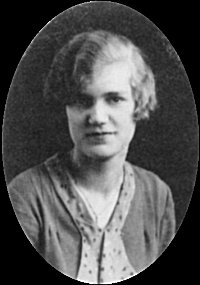Ester Boserup
Ester Boserup (born May 18, 1910 in Copenhagen , † September 24, 1999 in Geneva ) was a Danish agricultural economist . She is considered a pioneer of interdisciplinary research and made important contributions to the theory of agricultural development and gender research .
Live and act
Ester Børgesen was born in Copenhagen. Her father, an engineer, died when she was two years old. While studying, she married Mogens Boserup. After her studies, she worked from 1935 to 1947 for the Danish government as head of a planning authority, and from 1947 to 1965 in Geneva for the Economic Commission for Europe of the United Nations . There she did research mainly on agricultural trade. Between 1957 and 1960 she worked for the UN in India (with her husband and Gunnar Myrdal ), which had a great impact on her view of agricultural development.
In 1965 her most important book, The Conditions of Agricultural Growth , was published, in which she developed an alternative theory to the Malthusian trap . In contrast to Malthus , she showed that population growth in developing countries leads to innovations in agricultural techniques. Population pressure leads to agricultural intensification - the yield per area increases, in particular through higher labor input. Boserups work is often as an alternative to neo-Malthusianism seen. She also emphasized that subsistence agriculture and commercial agriculture are characterized by different motivational structures. The book also had an impact outside of agricultural science, including anthropology and geography ; it was reprinted several times and translated several times.
Influenced by her experiences in India and Senegal , Boserup wrote Women's Role in Economic Development (1970). In this work she emphasized the essential and at the time underestimated role of women in the economic development of poor countries. The book was picked up by the United Nations and contributed to the proclamation of the UN Decade for Women (1976–1985).
It was developed by the University of Wageningen (Agricultural Science), University of Copenhagen (economics) and Brown University each with an honorary doctorate awarded. In 1989 she was made a foreign associate of the National Academy of Sciences in the USA .
She and her husband, Mogens Boserup, had three children: Birte (born 1937), Anders (1940) and Ivan (1944).
Works
- The Conditions of Agricultural Growth: The Economics of Agrarian Change Under Population Pressure . Allen & Unwin, London 1965.
- Women's Role in Economic Development . Allen & Unwin, London 1970.
- Population and Technological Change: A Study of Long-Term Trends . Chicago University Press, Chicago 1981, ISBN 978-0-226-06674-5 .
- Population and Technology . Wiley-Blackwell, Oxford 1981, ISBN 978-0-631-13371-1 .
- My Professional Life and Publications, 1929-1998 . Museum Tusculanum Press, Copenhagen 1998, ISBN 978-87-7289-520-8 .
Individual evidence
- ↑ a b c d B. L. Turner II and Marina Fischer-Kowalski: Ester Boserup: An interdisciplinary visionary relevant for sustainability . In: PNAS . tape 107 , no. 51 , 2010, p. 21963-21965 , doi : 10.1073 / pnas.1013972108 ( pnas.org ).
- ↑ Irene Tinker: A Tribute to Ester Boserup: utilizing interdisciplinarity to analyze global socio-economic change. Retrieved October 30, 2017 .
| personal data | |
|---|---|
| SURNAME | Boserup, Ester |
| ALTERNATIVE NAMES | Ester Børgesen (maiden name) |
| BRIEF DESCRIPTION | Danish agricultural economist |
| DATE OF BIRTH | May 18, 1910 |
| PLACE OF BIRTH | Copenhagen |
| DATE OF DEATH | September 24, 1999 |
| Place of death | Geneva |
